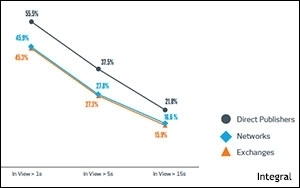Its name suggests otherwise, I know, but the viewability problem is supposed to get smaller, not bigger.
That’s not what’s happening.
A recent report from Integral Ad Science says just 45.3% of ads traded via exchanges were viewable in Q2 2014. That’s down from the 51.3% viewability
rate exchanges had in Q1 2014 and even lower than viewability rates on ad exchanges from Q4 2013 (47.4%).
Half a year later -- half a year with viewability as a focal point, no less -- and the
ad industry has gone backwards in its battle against viewability. The overall war is against ad quality, and exchanges are losing that too.
Integral gives ad exchanges a “true
advertising quality” (TRAQ) score based on a mix of fraud, viewability, ad clutter, brand safety and professionalism ratings. The TRAQ score for exchanges in Q2 2014 was 576 (out of
1000). That’s down slightly from the 578 score Integral gave exchanges in Q1 2014, which was down from the 597 score exchanges received in Q4 2013.
advertisement
advertisement
The Media Rating Council (MRC)
established viewability as a legitimate online ad currency for display advertising just before Q2 2014 began, with “viewability” meaning 50% of an ad’s pixels being in-view for at
least one second.
For its latest report, Integral also measured viewability rates based on time intervals of five and 15 seconds and found that 27.3% of ads traded on
exchanges were viewable for more than five seconds, and 15.9% were viewable for more than 15 seconds.
In a press release, Integral notes that viewability rates didn't improve despite the
MRC’s lifted advisory. “This is expected to change in the upcoming quarters, as the industry adjusts and adopts new expectations,” the company writes in its release. In its Q1 2014
report, though, Integral made a similar prediction, writing that viewability numbers were expected to increase because of the MRC’s lifted advisory.
That’s not to knock
Integral’s predictive powers, but it does show that viewability won’t automatically become less of a problem just because it's now being used as a currency and people are talking about it.
It’s a much more enigmatic predicament.
That much, at least, is viewable.